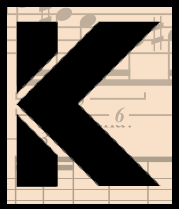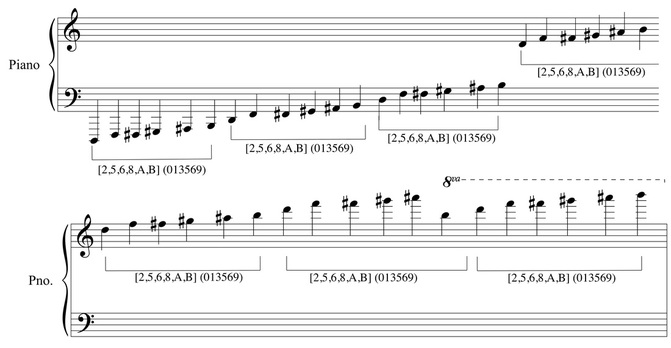|
Heads Up: the following entry contains a lot of set theory. For the sake of avoiding confusion, when referring to pc sets I will use A to represent the integer 10 (A#/Bb) and B to represent the integer 11(B-natural) I’ve always felt that one very useful benefit of the tonal system, even when highly chromatic, is that it contains built-in restrictions one must follow in order to adhere to the system successfully. Even a highly chromatic tonal work must, by definition, center around some kind of tonic, and any progression toward or away from that tonic is governed by a series of loose guidelines governed by the hierarchical relationship of scale degrees and chords to the tonic. The same cannot always be said of atonal music, especially atonal music based around pitch-class sets (pc sets). The composer must create his or her own restrictions in order to establish a unifying harmonic/pitch language within a work. This is not impossible, and there are countless organizational methods that composers have used throughout the 20th and 21st centuries; use of symmetrical sets, limited transpositions of a single set, serial procedures, Messiaen’s modes of limited transposition, and others. One method that (I believe) is lesser-known is the use of sieves, developed by Iannis Xenakis, Greek composer, architect and music-theorist. Xenakis was a pioneer in the use of applying principles of architecture and stochastic processes to his music through mathematically calculated pitch and rhythmic systems. Sieves can applied to rhythmic structures and pitch structures equally, but I will only be going over how to apply a sieve to pitch (a post on rhythm is in the works). I will discuss what a sieve is, how it is constructed, how it can be mapped to pitch and some of the benefits that can be gained from using this particular method of pitch organization. In simple terms, a sieve is a means of filtering. Mathematically speaking, it is the filtering of a set of numbers based on specific rules so that only some members of the set remain. Christopher Ariza defines a sieve as a formula consisting of one or more residual classes combined by logic operators. A residual class consists of two integer values, a modulus (M) and a shift (I). The modulus can be any positive integer greater than 0, and the shift can be any integer from 0 to M-1. A modulus and shift will be notated M@I (read modulus “M at shift I). Another way of notating a sieve is to represent it as as an integer (the factor or modulus) with a subscript integer to represent the shift. An example is 30, which represents the series [0, 3, 6, 9, 12…]. We can alter the shift and make it 31 to create the series [1, 4, 7, 10, 13...]. You can also combine two series together to create a new compound series. Take, for instance the following: 32 + 42 = s, in which s is the composite set of the two subset sieves 32 = [2, 5, 8, 11, 14…] 42 = [2, 6, 10, 14…] S = [2, 5, 6, 10, 11, 14…] and the set continues The example above is what we call a symmetrical periodic set. The two elements (32 and 42) are individually periodic sets, and when combined together they form the interval series [3,1,2,1,3], which is a symmetrical set. When the two residual classes have the same shift you can find their periodicity by multiplying the two factors. In this case 3 x 4 = 12, so every 12 integers each of the sets will be replicated, and therefore their superset [2,5,6,10,11,14] will be replicated. The shift value of 2 indicates that the series will replicate at every 14th integer (a period of 12 with a shift of 2 = 14). If we combine two residual classes with the same factor/modulus but different shift values we can create a periodic asymmetrical set. Take the collection below, for example: 120 + 122 + 124 + 125 + 127 + 129 + 1211 = [0,2,4,5,7,9,11] And with mod12 this set would be replicated following integer 11 This sieve represents the structure of a major scale. As the set replicates itself we have the same interval structure replicating itself over and over [2,2,1,2,2,2,1,2,2,1,2,2,2,1,…]. We can do the same for other scales: Natural Minor: 120 + 122 + 123 + 125 + 127 + 128 + 1210 = [0,2,3,5,7,8,10] Harmonic MInor 120 + 122 + 123 + 125 + 127 + 128 + 1211 = [0,2,3,5,7,8,11] Octatonic 120 + 121 + 123 + 124 + 126 + 127 + 129 + 1210 = [0,1,3,4,6,7,9,10] Whole-tone 120 + 122 + 124 + 126 + 128 + 1210 = [0,2,4,6,8,10] Sieves are not limited to just the harmonic structures of the tonal system. Any set of residual classes can be combined to form a sieve that can be mapped onto pitch space. Let’s look at the example above (32 + 42), which creates the set [2,5,6,8,10,11,14]. If we extend the sequence and then map it onto a mod12 pitch class space we get the set [2,5,6,8,A,B], with a prime form of (013569). We can map this onto pitch-class space, for instance the range of a piano, and we get the following series: This brings me back to my opening remarks about the built-in restrictions of the tonal system being a benefit of that particular harmonic/pitch language. How do sieves help solve this problem created with atonal pitch structures? The (32 + 42) sieve generates a repeating pattern of the same pitch classes in each octave, all of which have the prime form (013569). While this is useful for demonstrating the mapping of a sieve onto pitch space, it doesn’t allow for much variation in the harmonic language of a piece. I have often felt that even when I limit myself a single pc set, (0124589) for instance, that having all 12 transpositions of that set still leaves me with a mostly open use of all pitches within the octave. One solution is to not think within the confines of pc sets, but to think within the confines of the octave. It is possible to create a sieve that is a combination of repeating interval series that do not have regular points of periodicity (i.e. they do not overlap at the same point within the octave). Each octave can be broken into its own pc set, but the pitch characteristics will change within each octave. This is created by using two or more residual classes with different factor/modulus values and different shift values. (Sidenote: I have found it is best to use at least 3 interval series to fill out the register and not produce lots of large intervals between adjacent pitches). Take the following example: Using the range of the piano (0-87, where 0=A0) 60 + 91 + 77 = s 60 = [0, 6, 12, 18, 24, 30, 36, 42, 48, 54, 60, 66, 72, 78, 84] 75 = [5, 12, 17, 24, 31, 38, 45, 52, 59, 66, 73, 80, 87] 91 = [1, 10, 19, 28, 37, 46, 55, 64, 73, 82] S = [0, 1, 5, 6, 10, 12, 17, 18, 19, 24, 28, 30, 31, 36, 37, 38, 42, 45, 46, 48, 52, 54, 55, 59, 60, 64, 66, 72, 73, 78, 80, 82, 84, 87] And mapped onto pitch space (in which 0 represents A0, not C1) that would look like this: The example above demonstrates three overlapping interval series mapped onto pitch space. However, because each interval series is shifted by a different amount the three series do not overlap at regular points, creating different pitch content for each octave, and variation in the sequence of pc sets. This artificial scale created through filtering by intervals can now serve as the basis for all pitch structure within a piece. Each octave has a unique set of pitches and contains a unique pc set. If you are a composer who is more inclined to use transpositions of a single pc set, the sieve above might become problematic considering each octave has a unique pc set, and therefore, different harmonic characteristics. Another method of creating a sieve is to structure the interval series in a similar fashion as the sieves for major and minor scales above, but with a modulus value that is not 12. Take the following: 100 + 101 + 102 + 103 + 106 + 107 = [0,1,2,3,6,7,10,11,12,13,16,17,20,21,23,26,27…] This method creates the same variation in pitch content per octave, but results in a concatenated series of the same pc set. The consistent modulus of 10 begins the series on a pitch class that is a minor 7th above the first pitch class in the previous series (e.g. if the first pc set begins on 9 (A), the next pc set will begin on 7 (G), the next on 5 (F) and so on). If we were to map this onto the range of the piano it would look like this: This method of generating a sieve is beneficial for working with the same pc set, but not leaving yourself open to all transpositions mapped to the entire range of the keyboard. It is still up to the composer to develop a meaningful way to use these materials, but using a sieve as a jumping-off point can be very helpful in establishing a harmonic/pitch language that is atonal and has some of the freedom of “free atonality” using pitch sets and the unification of pc sets and subsets that can be gained from more structural approaches such as serial or 12-tone technique. Upon first learning about sieves I used them in a couple of pieces with relative success. More recently I find myself turning to sieves for generating pitch structures in all of my works. I have experimented with free atonality, serial techniques, stochastic pitch generation, Messiaen’s MOLT (you name it, I’ve probably tried it), but I find that sieves provide me with the perfect balance between a structured pitch/harmonic system and the freedom to choose how I want to order and organize those pitches linearly and vertically. For more information on sieves, check out the following links.
You can also check out the chapter on sieves in Xenakis’ own Formalized Music Keep an eye out for the next topic on sieves applied to rhythmic structures.
4 Comments
2/11/2018 05:59:59 pm
Thanks for this useful page. There are a couple of errors, however, which confused me for a while, until I realised that they were errors. In the second-to-last example, you list 7@5 = [5, 12, 17, 24, 31, 38, 45, 52, 59, 66, 73, 80, 87], but the third item should be 19 (because 19 mod 7 is 5). All the other items there after should also be 2 higher.
Reply
Jon
2/11/2018 06:17:01 pm
Hi, Michael. Thanks for the heads up! I’ll change those ASAP. I can’t believe no one caught that sooner.
Reply
Michael Norris
2/11/2018 06:34:18 pm
Yes, that's me. You might be interested in some of the music theory resources on my website: www.michaelnorris.info — I haven't added a sieve calculator, but I'm thinking about it now!
Jörgen
4/2/2021 01:04:05 am
Great post! Easy to understand! When will you make the post about rythmical sieves?
Reply
Leave a Reply. |
The "Direct Sound" Page is dedicated to general blog posts and discussions. Various topics are covered here.
Full Directory of Articles |




